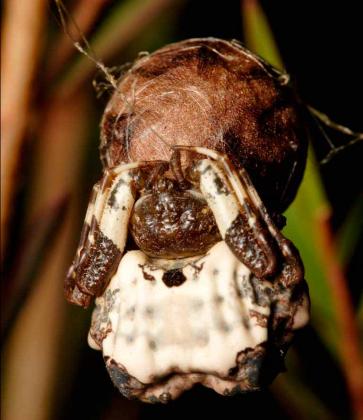A range of teacher professional learning programs will be developed to accompany the Biodiversity of the Western Volcanic Plains online outreach...

Bird-dropping Spider
Celaenia excavata
Feeds at night, using mimicry to capture its prey. It hangs from the edge of a leaf or twig on a short silk thread, with its forelegs stretched out. It releases a chemical scent (pheromone) that mimics the scent released by female moths to attract their mates. If male moths attracted by the spider's mimicking scent flutter close enough they are grabbed by the spider's strong front legs. The egg sacs are marbled brown coloured balls, about 12-14 mm wide, each holding more than 200 eggs. Up to 13 sacs are joined together in a group.
| Details | Description |
| Type | Invertebrate |
| Group | Arachnid - Spider |
| Other Common Names | Death's Head Spider, Orchard Spider |
| Identifying Characteristics | |
| Distinctive Markings | Shape, colour pattern and resting position help this spider look like a bird dropping. It usually holds its legs folded in against its body. |
| Diet | Carnivore. Mainly eats male moths. |
| Habitat | Found in open woodlands and urban gardens. |
| Native Status | Native to Australia |
| Taxonomy | |
| Phylum | Arthropoda |
| Class | Arachnida |
| Order | Araneae |
| Family | Ardeidae |
| Genus | Celaenia |
| Species | excavata |

Distribution maps indicate current and historic locations where species have been sighted.
Source: Atlas of Living Australia
| Conservation Status | |
| DEPI Advisory List | Not listed |
| FFG Act | Not listed |
| EPBC Act | Not listed |
The conservation status of species is listed within Victoria and Australia.
The Department of Environment and Primary Industry (DEPI) Advisory List consists of non-statutory advisory lists of rare or threatened flora and fauna within Victoria.
The Flora and Fauna Guarantee Act 1988 (FFG Act) lists threatened species in Victoria. Under the Act, an Action Statement is produced for each listed species.
The Environment Protection and Biodiversity Conservation Act 1999 (EPBC Act) is the Australian Government’s key piece of environmental legislation, listing nationally threatened native species and ecological communities.



